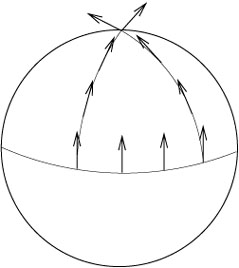The conservation of energy doesn't even apply to static curved space in general.
The Einstein Field Equations are defined as:
The two important terms for energy conservation (or the lack of it) are the g(uv) and T(uv) terms in the equations.
g(uv) are the coefficients of the metric tensor that define the geometry of spacetime.
For example in the metric that defines flat spacetime ds²=c²dt²- dx²- dy²- dz², the coefficients of g(uv) are g(00)=1, g(11)=g(22)=g(33)=-1
The T(uv) tensor term in the right hand side of the equation defines the energy matter tensor.
If energy is conserved then its partial derivative with respect to time is zero.
Here lies the problem in 2D flat space (which can be generalised to higher dimensions) using Cartesian coordinates the partial derivative is defined by:
In this case the direction of the projection vector as h approaches zero is unchanging hence we can define the partial derivative.
In curved space however the definition does not work as the projection vector does change direction.
This can be illustrated by the change of a projection vector as it moves along the arcs on the surface of a sphere.
The concept of the derivative in curved space needs to be redefined which factors in the changes in the projection vectors.
In this case we need to calculate the partial derivatives of the metric tensor components which define the geometry of the spacetime in which the projection vectors change.
Without going in specific details which would require a detailed knowledge of tensor analysis the derivative of a tensor known as the
covariant derivative is defined as:
The left hand side of the equation is the covariant operator applied to a vector v.
The first term on the right hand side is the normal partial derivative of the vector, the next term contains information how the metric tensor components g(uv) change by calculating their partial derivatives which impacts on changes to the projection vector.
The operator in the second term is known as a Christoffel symbol and is defined as
When the covariant operator is applied to the second rank energy matter tensor T(uv) and assuming the covariant derivative is zero we obtain the following result.
Now we have a “problem”.
As shown previously the conservation law applies when the partial derivative (the first term) equals zero.
This is not an issue with flat static space since all the g(uv) coefficients are constant and their partial derivatives vanish, in which case the second and third terms are zero.
The second and third terms do not vanish for curved spacetime nor for expanding spacetime even when flat since the g(uv) coefficients are now time dependant and have non vanishing terms with respect to the time derivative.
There is a physical reason why conservation of energy is not applicable under these conditions.
Since GR is a non linear theory for gravity unlike Newtonian gravity, not only does mass contribute to gravity but also the gravitational field.
Energy is not conserved as energy can be exchanged between mass and the corresponding gravitational fields.
This was recognized by Einstein and Hilbert well before the advent of expanding cosmologies such as the Big Bang or Steady State.








